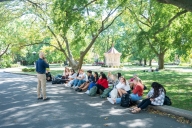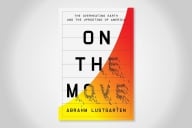You have /5 articles left.
Sign up for a free account or log in.
The path that Apple’s newly announced Vision Pro augmented reality headset will travel across higher education is predictable.
The key to understanding how virtual and augmented reality will play out in academia, and the future of Apple’s new $3,500 device (launching next year), is to think in 10-year increments.

Years 0 to 2: Skepticism and Ideation
Over the next couple of years, the reaction to Apple Vision Pro across higher education will be polarized.
Most people will be deeply skeptical that Apple’s new product, and the growing number of other AR/VR products offered by competitors will amount to much in higher ed. With Vision Pro in particular, skeptics will point to the product’s high expense, closed ecosystem and lack of applications explicitly targeted at education. The consensus will be that augmented and virtual reality are overhyped and looking for technological solutions to solve educational challenges is a mistake.
A smaller group in and around higher education will get excited about the potential of Apple’s Vision Pro and other similar (less expensive) technologies. They will ideate scenarios in which augmented reality and spatial computing can solve real-world educational challenges, such as laboratory and hands-on training. (Think gross anatomy lab without the cadavers.) Others will imagine a new world of immersive online learning, virtual seminars and digitally mediated collaborative projects.
Years 3 to 7: Experimentation and Failure
In years three to seven, many of the higher education–related ideas developed after the launch of Apple Vision Pro will move into the experimentation stage. There will be lots of activity across colleges and universities to incorporate AR/VR tech into teaching and learning. Most of these experiments across higher education with Apple Vision Pro (and other similar technologies) will fail. Or at least they will be judged a failure by most of the higher ed community.
The reasons for these failures will have to do as much with how higher education works as the limitations of the technology. Enthusiasm and funding for experimentation with AR/VR will be inconsistent. Campus champions of the technology will either move on to other roles. Budgets will be slashed.
All the while, however, a core of educators and technologists will keep learning. They will not view the failure of products like Apple Vision Pro to “revolutionize” education as a surprising or negative outcome, as they never believed that was the goal. Instead, these campus innovators will slowly build an infrastructure for the next stage of AR/VR tech in higher education.
Years 8 to 10: Integration and Normalization
In years eight to 10 (the early 2030s), products like Apple’s Vision Pro will have transitioned to a normal, accepted and integrated component of educational technology. Both the hype and the skepticism of years past will seem misplaced. Augmented and virtual reality will not have displaced other educational technologies but instead joined them as part of our teaching and learning tool kits.
Of course, the technology will have evolved substantially by this time, overcoming most of the limitations at launch. What was once an expensive ski goggle with a dangling power cord will now be an inexpensive pair of spectacles, indistinguishable from today’s eyeglasses.
If the Apple Vision Pro is to follow this 10-year higher education arc, then how should we react today? We can decide to be both less skeptical and less enthralled. Let’s get excited about experimenting with the tech and find ways to let those on our campuses most fascinated by AR and VR have some resources, space, time and running room to try things out.
At the same time, let’s avoid any talk about what tech like Apple’s Vision Pro will do to “revolutionize” anything about teaching and learning. That future will never arrive. At best, we will see integration and normalization, and that process will take years to play out.








